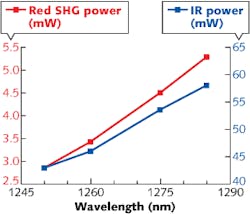LASERS FOR SPECTROSCOPY: Simple source produces femtosecond mid-IR pulses
Mid-infrared (mid-IR) lasers emitting in the so-called “fingerprint” spectral region of 5 to 20 μm can help detect and identify many organic materials and are useful in biology, medicine, and the food, plastics, and pharmaceutical industries, among others. Combine mid-IR wavelengths with ultrashort laser pulses and the uses multiply, due to the nonlinear effects of ultrafast pulses.
But high-power femtosecond mid-IR laser setups are usually complex. Researchers Yuhong Yao and Wayne Knox at the University of Rochester’s Institute of Optics (Rochester, NY) are working with a simpler approach in which the soliton self-frequency shift in a photonic-crystal fiber (PCF) is used to generate red-shifted solitons, which are then difference-frequency mixed with light from the pump laser. The researchers presented their results at the postdeadline sessions for the Optical Society’s (OSA’s) annual meeting, Frontiers in Optics 2012 (October 14–18, Rochester, NY).1
AGS crystal instead of GaSe
Yao and Knox are boosting the energy of the typically weak pulses generated by this sort of setup. They do this by using a PCF that has two zero-dispersion wavelengths (ZDWs) rather than the single ZDF of a conventional PCF. A single ZDF limits a PCF to producing a broadband supercontinuum in which the intensity per spectral interval is lower than optimum; dual ZDWs in a single PCF can be spectrally spaced closely together to produce a dual-peak narrowband continuum with high spectral intensity.
The result is a source that emits a 40 MHz pulse train at 2.4 to 3 mW of average power; the wavelength can be tuned between 5.3 and 6 μm. The system is scalable to higher average power; the researchers note that other mid-IR wavelength ranges can be reached either by using PCFs with different ZDWs or by tapering the PCF to change the fiber dispersion profile.
AGS crystal instead of GaSe Yao and Knox custom-built a ytterbium-fiber chirped-pulse amplifier (CPA) that produces pulses with a 320 fs width at 40 MHz for an average power of 1.36 W; the pulses have a 1035 nm peak wavelength and a bandwidth of 15 nm. Part of the CPA’s output is coupled into a section of commercial PCF with two ZDWs at 1022 and 1075 nm, made by Crystal Fibre (now part of NKT Photonics; Birkerød, Denmark). The rest of the CPA power is used in the pump arm of the setup, which is synchronized with the signal arm using an adjustable delay line, and mode-matched with a telescope.
The difference-frequency-generation (DFG) crystal is a 2-mm-thick slab of silver gallium sulfide (AgGaS2, or AGS) cut at 50° (see figure). The researchers say they picked AGS over the more conventional gallium selenide (GaSe) due to the lower surface loss, birefringence, and group-velocity dispersion of AGS, as well as its more circular output beam and lower pulse broadening from group-velocity mismatch.
At an 86 mW threshold power, the setup begins to produce a Stokes side continuum with most of its power in a single peak; the peak wavelength can be adjusted between 1250 and 1285 nm and a power on the order of 50 mW. When the wavelength is changed, the phase-matching angle of the DFG crystal is adjusted to maintain output.
The result is an output tunable from 5.3 μm to 6 μm, with the maximum power of 3 mW reached at 5.5 μm. Frequency cross-correlation traces can be obtained by measuring output power as a function of the delay created by the adjustable delay line, giving a 220 fs width (the actual output pulse duration is a bit longer due to dispersion and pulse broadening).
Ultrafast spectroscopy of organic compounds containing carbon-carbon double bonds and carbon-oxygen double bonds are possible within the device’s output wavelength range; this includes amino acids and proteins.
REFERENCE
1. Y. Yao and W. H. Knox, “Femtosecond mid-IR laser source based on intense Stokes pulse generation in a photonic crystal fiber,” Session FW6B.1, FiO 2012 Postdeadline Papers, ISBN 978-1-55752-955-8.
About the Author
John Wallace
Senior Technical Editor (1998-2022)
John Wallace was with Laser Focus World for nearly 25 years, retiring in late June 2022. He obtained a bachelor's degree in mechanical engineering and physics at Rutgers University and a master's in optical engineering at the University of Rochester. Before becoming an editor, John worked as an engineer at RCA, Exxon, Eastman Kodak, and GCA Corporation.

